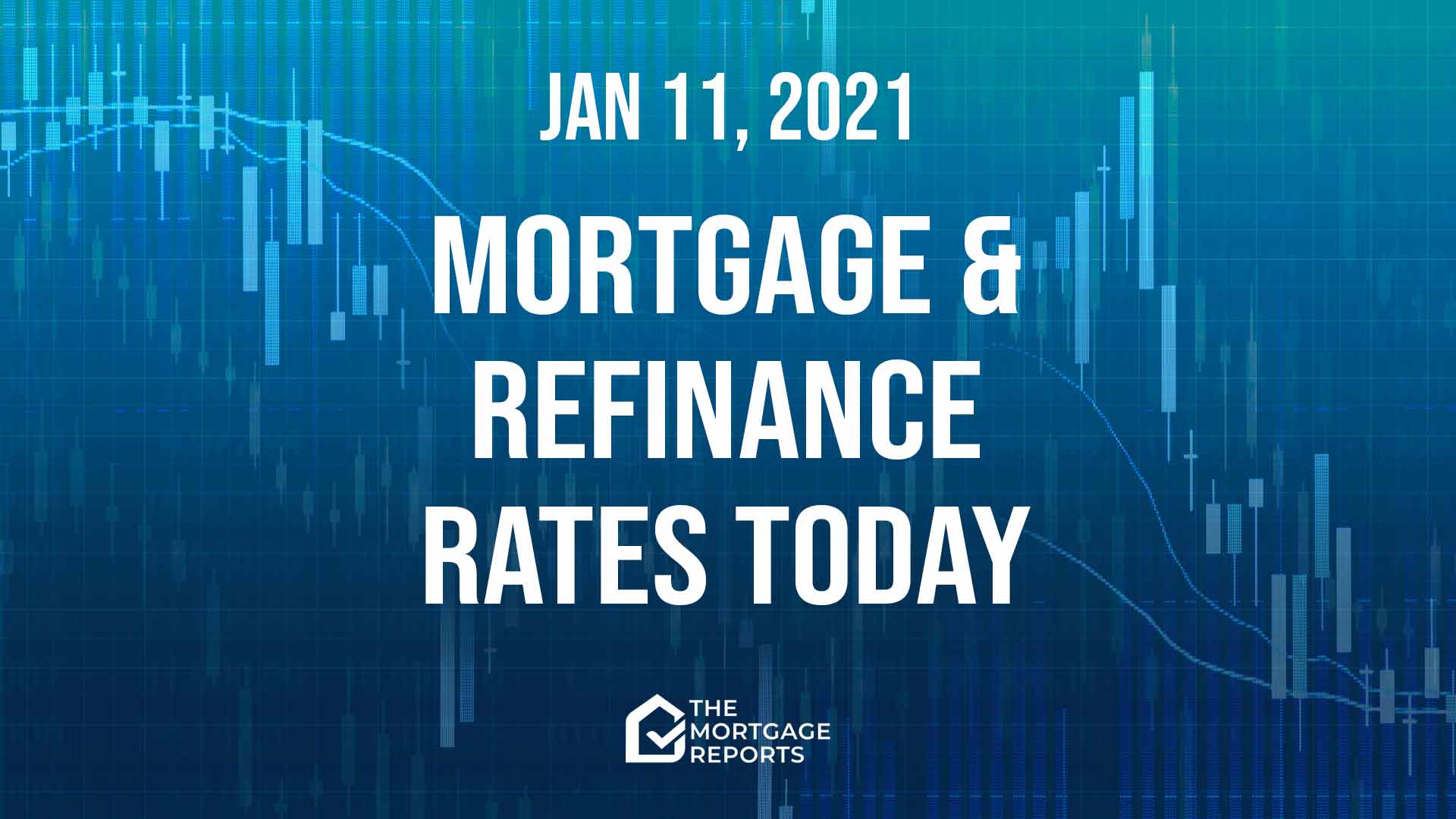
Today’s mortgage and refinance rates
Average mortgage rates edged higher again last Friday. So they’re appreciably higher than they were this time last week. But, even so, they remain within the ultralow range.
So far this morning, market activity suggests mortgage rates may rise again today.
Find and lock a low rate (Jan 12th, 2021)Current mortgage and refinance rates
| Program | Mortgage Rate | APR* | Change |
|---|---|---|---|
| Conventional 30 year fixed | |||
| Conventional 30 year fixed | 2.75% | 2.75% | Unchanged |
| Conventional 15 year fixed | |||
| Conventional 15 year fixed | 2.313% | 2.313% | Unchanged |
| Conventional 5 year ARM | |||
| Conventional 5 year ARM | 3% | 2.743% | Unchanged |
| 30 year fixed FHA | |||
| 30 year fixed FHA | 2.5% | 3.478% | Unchanged |
| 15 year fixed FHA | |||
| 15 year fixed FHA | 2.438% | 3.38% | Unchanged |
| 5 year ARM FHA | |||
| 5 year ARM FHA | 2.5% | 3.226% | Unchanged |
| 30 year fixed VA | |||
| 30 year fixed VA | 2.375% | 2.547% | Unchanged |
| 15 year fixed VA | |||
| 15 year fixed VA | 2.125% | 2.445% | Unchanged |
| 5 year ARM VA | |||
| 5 year ARM VA | 2.5% | 2.406% | Unchanged |
| Rates are provided by our partner network, and may not reflect the market. Your rate might be different. Click here for a personalized rate quote. See our rate assumptions here. | |||
COVID-19 mortgage updates: Mortgage lenders are changing rates and rules due to COVID-19. To see the latest on how coronavirus could impact your home loan, click here.
Should you lock a mortgage rate today?
Future mortgage rates sit on a knife-edge as two competing influences look set to do battle over their future direction. So deciding whether to lock your rate or float it depends largely on your personal appetite for risk.
Read on for more details about this possibly epic conflict. But, for now, my personal rate lock recommendations are:
- LOCK if closing in 7 days
- LOCK if closing in 15 days
- LOCK if closing in 30 days
- FLOAT if closing in 45 days
- FLOAT if closing in 60 days
Still, with so much uncertainty at the moment, your instincts could easily turn out to be as good as mine — or better. So be guided by your gut and your personal tolerance for risk.
Market data affecting today’s mortgage rates
Here’s the state of play this morning at about 9:50 a.m. (ET). The data, compared with about the same time yesterday morning, were:
- The yield on 10-year Treasurys rose to 1.13% from 1.09%. (Bad for mortgage rates) More than any other market, mortgage rates normally tend to follow these particular Treasury bond yields, though less so recently
- Major stock indexes were lower on opening. (Good for mortgage rates.) When investors are buying shares they’re often selling bonds, which pushes prices of those down and increases yields and mortgage rates. The opposite happens when indexes are lower
- Oil prices rose to $51.66 from $51.58 a barrel. (Neutral for mortgage rates* because energy prices play a large role in creating inflation and also point to future economic activity.)
- Gold prices fell to $1,839 from $1,872 an ounce. (Bad for mortgage rates*.) In general, it’s better for rates when gold rises, and worse when gold falls. Gold tends to rise when investors worry about the economy. And worried investors tend to push rates lower
- CNN Business Fear & Greed index — Fell to 61 from 71 out of 100. (Good for mortgage rates.) “Greedy” investors push bond prices down (and interest rates up) as they leave the bond market and move into stocks, while “fearful” investors do the opposite. So lower readings are better than higher ones
Caveats about markets and rates
Before the pandemic and the Federal Reserve’s interventions in the mortgage market, you could look at the above figures and make a pretty good guess about what would happen to mortgage rates that day. But that’s no longer the case. The Fed is now a huge player and some days can overwhelm investor sentiment.
So use markets only as a rough guide. They have to be exceptionally strong (rates are likely to rise) or weak (they could fall) to rely on them. But, with that caveat, so far mortgage rates look set to move higher.
Find and lock a low rate (Jan 12th, 2021)
Important notes on today’s mortgage rates
Here are some things you need to know:
- The Fed’s ongoing interventions in the mortgage market (way over $1 trillion) should put continuing downward pressure on these rates. But it can’t work miracles all the time. And read “For once, the Fed DOES affect mortgage rates. Here’s why” if you want to understand this aspect of what’s happening
- Typically, mortgage rates go up when the economy’s doing well and down when it’s in trouble. But there are exceptions. Read How mortgage rates are determined and why you should care
- Only “top-tier” borrowers (with stellar credit scores, big down payments and very healthy finances) get the ultralow mortgage rates you’ll see advertised
- Lenders vary. Yours may or may not follow the crowd when it comes to daily rate movements — though they all usually follow the wider trend over time
- When rate changes are small, some lenders will adjust closing costs and leave their rate cards the same
- Refinance rates are typically close to those for purchases. But some types of refinances are higher following a regulatory change
So there’s a lot going on here. And nobody can claim to know with certainty what’s going to happen to mortgage rates in coming hours, days, weeks or months.
Are mortgage and refinance rates rising or falling?
Today
I’m expecting mortgage rates to rise today.
There’s talk, above, about an epic conflict. That may be overstating it. But there’s a real possibility of volatility over the next few months as competing influences try to push mortgage rates up and down at the same time.
Further ahead
On one side, we’re likely to see much higher government borrowing in coming months as the new administration fights the economic and public health effects of the COVID-19 pandemic.
It also has other economic plans that would require more national debt, at least in the short run. Indeed, last Friday, President-elect Joe Biden promised stimulus spending “in the trillions of dollars.”
But more debt traditionally means higher yields on the US Treasurys that fund that debt. Given that mortgage rates often shadow Treasury yields, that additional borrowing should exert upward pressure on those.
But, on the other side and at the same time, the pandemic is wreaking huge damage on the US and global economies. And bad economies tend to have low rates.
We saw this battle between competing influences last Friday. That’s when a pretty terrible employment situation report was released. Normally, mortgage rates would have plummeted on the news. But they didn’t, presumably because investors took the prospect of higher bond yields more seriously than the number of jobless.
But Friday was just one day. And the balance of power in this conflict may ebb and flow, perhaps frequently. So I can’t offer you any certainty over the direction of rates. But I can suggest we’re likely to see more volatility than we’ve recently grown accustomed to.
Recently
Over the last several months, the overall trend for mortgage rates has clearly been downward. And a new, weekly all-time low was set on 16 occasions last year, according to Freddie Mac.
The most recent such record occurred on Jan. 7. But that had already been overtaken by events, even before it was published. And rates are now appreciably higher.
Expert mortgage rate forecasts
Looking further ahead, Fannie Mae, Freddie Mac and the Mortgage Bankers Association (MBA) each has a team of economists dedicated to monitoring and forecasting what will happen to the economy, the housing sector and mortgage rates.
And here are their current rates forecasts for each quarter of 2021 (Q1/21, Q2/21, Q3/21 and Q4/21).
However, note that Fannie’s (released on Dec. 15) and the MBA’s (Dec. 21) are updated monthly. But Freddie’s are now published quarterly. And its latest was released on Oct. 14. So that’s looking distinctly stale.
The numbers in the table below are for 30-year, fixed-rate mortgages:
| Forecaster | Q1/21 | Q2/21 | Q3/21 | Q4/21 |
| Fannie Mae | 2.7% | 2.7% | 2.8% | 2.8% |
| Freddie Mac | 3.0% | 3.0% | 3.0% | 3.0% |
| MBA | 2.9% | 3.0% | 3.2% | 3.2% |
But these predictions were made before the Democratic Party achieved a clean sweep of both houses of Congress and the White House. And before the pandemic became even more virulent. So they may change more this month than they do normally.
Find your lowest rate today
Some lenders have been spooked by the pandemic. And they’re restricting their offerings to just the most vanilla-flavored mortgages and refinances.
But others remain brave. And you can still probably find the cash-out refinance, investment mortgage or jumbo loan you want. You just have to shop around more widely.
But, of course, you should be comparison shopping widely, no matter what sort of mortgage you want. As federal regulator the Consumer Financial Protection Bureau says:
Verify your new rate (Jan 12th, 2021)Shopping around for your mortgage has the potential to lead to real savings. It may not sound like much, but saving even a quarter of a point in interest on your mortgage saves you thousands of dollars over the life of your loan.



